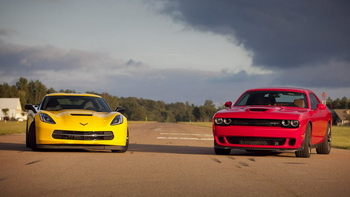Vette News - Corvette vs Challenger

We're converging on the drag strip, 40 minutes or so away, when I finally get someone
there on the phone. They're not open, despite what it says on their web site. This presents
a problem, because I've got a 2015 Chevy Corvette Stingray and The Wall Street Journal's Dan
Neil has a 2015 Dodge Challenger SRT Hellcat-nearly 1,200 horsepower of righteous American thunder,
and now no place to use it.
But I have a Plan B, and a short while latr we're at a rural airport, taxiing down the access
road and lining up for takeoff. Which is quicker, a Corvette or a Hellcat? I think I probably
know, but we'd better do this just make sure.
On paper, it looks like a bloodbath: the Hellcat has 707 horsepower to the Corvette's mere 460.
But horsepower isn't the only factor at play here. For one thing, the Vette weighs about 1,100
pounds less than the Hellcat. With its rear transaxle - in this car, the new eight-speed automatic -
the Vette has a higher percentage of its weight over the rear tires, which are also 10 millimeters
wider than the Hellcat's. And while the Chevy has the frontal area of a Sharpie, the Hellcat is more
like a Shar-Pei.
Digest all that, and a betting man might guess that the Vette will actually beat the Hellcat off the
line, but that the Hellcat will eventually reel it in. I mean, 247 horsepower is still a pretty major
advantage. I mark off a quarter-mile, per the Vette's onboard data-logging system, and return to the
end of the runway to line up with the towering Dodge.
Vette in the right lane, Hellcat in the left, I roll down my window so we can verbally time the launch.
Three… two… one… Go. The yellow Chevy squats down, hooks up and leaves the Hellcat at the line, where
it's fighting for traction. I've seen a four-second 0-60 time out of a Hellcat, but getting there requires
a perfect launch - second gear on the eight-speed automatic, not too much throttle. Under ideal circumstances,
the Hellcat will turn a low 11-second quarter-mile time. The Corvette will run high 11s, but it's pretty much
idiot-proof. Just floor the throttle and go. This might be closer than we expected.
Since my window is still down, I hear the Hellcat before I see it. We're about halfway to our nominal finish
line, the Vette roaring past 100 mph, its optional performance exhaust in full straight-pipe mode. There's a
lot of noise. And yet there's something even noisier barging up the left lane of our improvised Autobahn.
The Hellcat's supercharger displaces 2.4 liters, turns 14,600 rpm and draws air through a hole where one of
the headlights should be. I'm sure that in the slipstream there's a lot of exhaust noise, but from my rare
position just ahead of a hell-bent Hellcat, it's all supercharger whine. The Hellcat is gulping its share
of the atmosphere and shoving the rest rudely aside.
Another fun stat: The Hellcat has almost 26 square feet of frontal area. It's a noble edifice, the Challenger.
By about 105 mph, the Hellcat and Vette are door to door. By 110, he's pulled in front. At 120 the Hellcat
is walking away. Then we hit the brakes. Our unscientific conclusion: The Vette launches harder off the line,
but the Hellcat will inexorably reel it in if you give it enough runway. Above 100 mph, the Dodge eats the Vette
alive. At least, that's what we think. But we'd better go back around and do this again. Just to be sure.
Source: Yahoo news